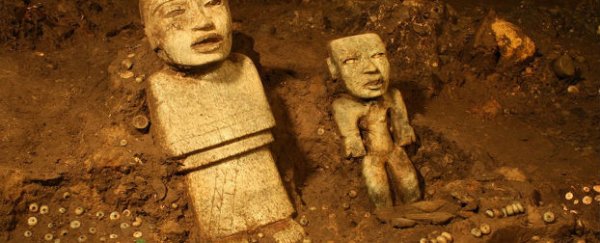Back in 2003, archaeologists from Mexico's National Institute of Anthropology discovered a secret tunnel beneath the remains of the ancient and enormous city of Teotihuacan in Mexico. After heavy rains exposed what could be an opening, the team used radar technology to confirm the presence of the tunnel more than 12 metres below the Temple of the Feathered Serpent - the third largest pyramid in Teotihuacan after the Pyramid of the Sun and the Pyramid of the Moon.
The tunnel's entrance had been sealed by the city's inhabitants more than 1,800 years ago, using piles of rocks and the bodies of hundreds of human sacrifices, which suggested that something very important had been closed inside.
It took almost a decade for the team to figure out how to get down to the tunnel's entrance, but in 2010, they finally got a little robot down there. Equipped with a pair of romote-controlled mechanical arms and a video camera, the robot crawled all the way down to the end of the tunnel to find the entrances of several crypts.
"For a long time local and foreign archaeologists have attempted to locate the graves of the rulers of the ancient city, but the search has been fruitless," lead archaeologist Sergio Gomez told reporters at the time. A year later he told the Associated Press, "If confirmed, it will be one of the most important archaeological discoveries of the 21st century on a global scale."
This week Gomez's team announced the discovery of some 50,000 incredibly preserved ritual objects placed at the entrance of three crypts, which could mean whoever was buried inside was either royal, or at least very important. According to Gail Sullivan from The Washington Post, the objects include finely detailed stone figures, jewellery, shells, obsidian blades, and arrowheads.
"Due to the magnitude of the offerings that we've found, it can't be in any other place," Gomez told reporters this week. "We've been able to confirm all of the hypotheses we've made from the beginning."
The team has so far only made it half a metre into the burial chambers, but they say they'll continue their excavation efforts next year.
"Discovery of tombs may unlock long-held mysteries of a civilisation that left no written records of its existence, including how it was governed and whether leadership was hereditary," says Sullivan.
For unknown reasons, the city of Teotihuacan was abandoned by its original inhabitants around 700 AD, and then the Aztecs rediscovered it during the 14th century. They gave the city its name, Teotihuacan, which means "the birthplace of the gods" in the Nahuatl language.
Sources: The Washington Post
